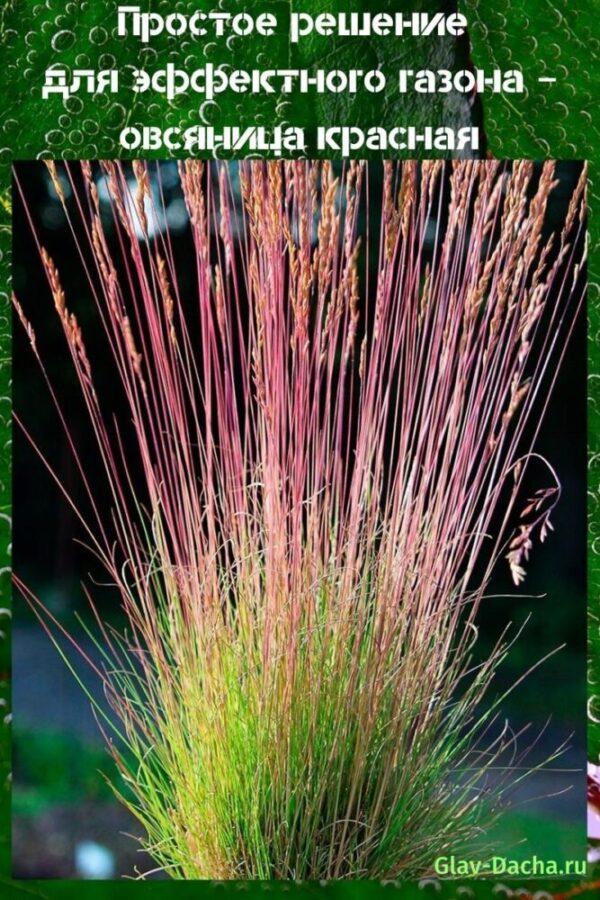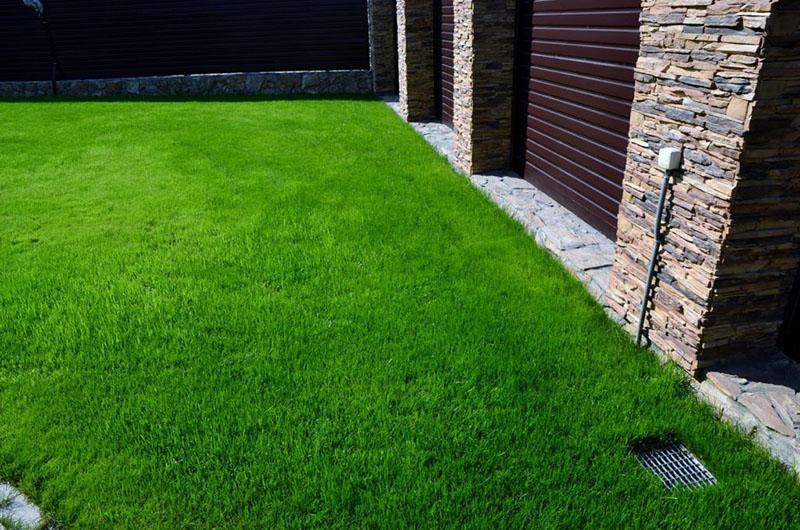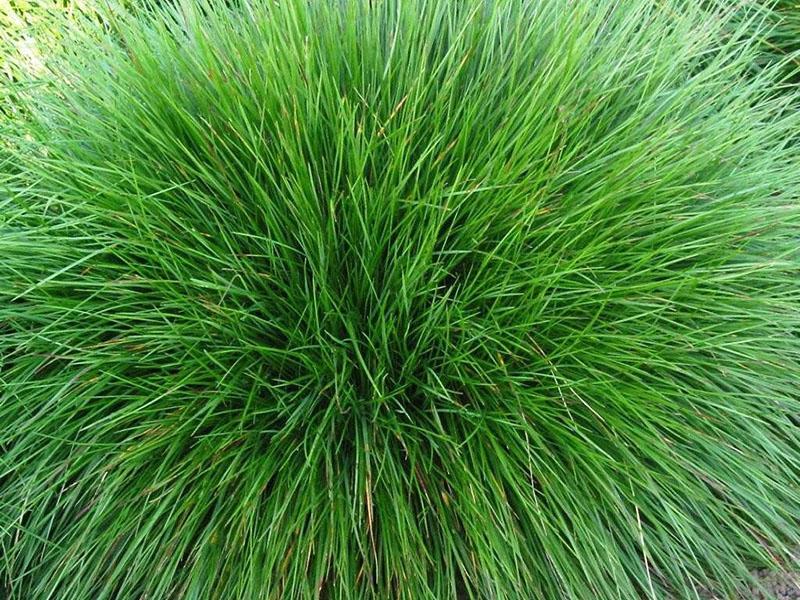A simple solution for a spectacular lawn - red fescue
 Red fescue is a perennial herb popular as a lawn. It evenly covers the soil with a bright green carpet, perfectly adapts to any climatic conditions and reproduces quickly by self-seeding. This is an excellent solution for creating a quality garden lawn with minimal effort.
Red fescue is a perennial herb popular as a lawn. It evenly covers the soil with a bright green carpet, perfectly adapts to any climatic conditions and reproduces quickly by self-seeding. This is an excellent solution for creating a quality garden lawn with minimal effort.
Red fescue - description and features

Fescue combines several varieties of perennial grasses ranging in height from 20 to 70 cm. They have a creeping rhizome, due to which they quickly spread over a large area. The leaves are narrow and long, directed upward along the stem. They can be painted in different shades of green, blue and gray, some are covered with a waxy coating.
The decorative fescue lawn remains for 10-15 years. In the first year after sowing, it is not too thick and covers the soil only after 2-3 months. Then the fescue grows and completely covers the ground. This is due to the independent propagation of the grass by seeds, as well as the rapid growth of the rhizome.
Red fescue is propagated by seeds. They appear in the summer, after the end of the flowering period. The seeds are oblong, dark and very small. 1 g of sowing mass can contain up to 1000 seeds. They are sold ready for sowing, in packages from 1 to 15 kg or more. The recommended planting density is 30-35 g per 100 square meters of land.
The description of red fescue indicates that the life of the lawn is up to 15 years. However, it is possible to achieve such terms only on condition of regular watering and top dressing.
Care and cultivation
 Red fescue seeds are used for planting and reproduction. They are sold in large packs and are designed to create lawns. For sowing, it is recommended to choose a flat area with good drainage, with sufficient sunlight. It is cleaned of weeds, stones and other objects, and then dug up. Even before sowing seeds, it is recommended to add organic fertilizersthat will accelerate the growth of the grass. Also useful are universal mineral dressings with the addition of potassium, nitrogen and phosphorus.
Red fescue seeds are used for planting and reproduction. They are sold in large packs and are designed to create lawns. For sowing, it is recommended to choose a flat area with good drainage, with sufficient sunlight. It is cleaned of weeds, stones and other objects, and then dug up. Even before sowing seeds, it is recommended to add organic fertilizersthat will accelerate the growth of the grass. Also useful are universal mineral dressings with the addition of potassium, nitrogen and phosphorus.
To make the lawn even and neat, it is worth considering the basic requirements of fescue for cultivation and care:
- soil type - the plant can develop on any soil, except for the dense clay type, prefers moist sandy and light loamy with the addition of humus;
- watering regime - fescue easily tolerates summer drought, but can lose color brightness and stop growing;
- illumination - a well-lit area under the open sun is selected for sowing, but the lawn does not lose its appearance during prolonged darkening;
- mowing - suitable for regular mowing and lawn formation, while it is important to leave at least 4-5 cm of grass above the soil level;
- frost resistance - easily tolerates winter in temperate climates and goes under green snow in autumn, quickly recovers after being under a crust of ice;
- diseases - has good immunity against fungal infections, including powdery mildew and rust.
 Fescue looks impressive on its own, but is also added to complex lawn formulations. It is combined with ryegrass and meadow bluegrass. You can prepare the mixture yourself by combining several types of seeds. The fescue lawn acquires the most decorative appearance for 3-4 years. The first few months after planting, there may be empty areas, which in the future will also be filled with grass.
Fescue looks impressive on its own, but is also added to complex lawn formulations. It is combined with ryegrass and meadow bluegrass. You can prepare the mixture yourself by combining several types of seeds. The fescue lawn acquires the most decorative appearance for 3-4 years. The first few months after planting, there may be empty areas, which in the future will also be filled with grass.
Before sowing your lawn, it is important to prepare a good drainage... If red fescue tolerates drought easily, then waterlogging of the area leads to the rapid death of the plant. It is enough to provide moisture drainage in rainy weather or to form a lawn on a small hill.
Plant varieties
For growing at home, there are 3 main varieties of fescue. They differ in appearance, but combine all the advantages of the species: ease of maintenance, resistance to weather conditions, uniform distribution over the site.
The best representatives:
- Red fescue is a variety that forms a uniform lawn of bright green color. The leaves are narrow, erect, without wax bloom. At the end of spring, the flowering period begins, neat inflorescences-panicles of a dark red-brown shade appear. The plant is included in most shade mixes because it retains rich color in shaded areas.

- Red haired fescue is the most persistent and unpretentious variety. It forms a dense, dense cover due to the presence of underground shoots (rhizomes). They spread throughout the entire area, so the lawn is uniform. Red hair fescue is often used not only for landscaping and gardening of local areas, but also for decorating lawns for playing golf.

- Tough red fescue is another popular species. This plant has no underground shoots, but the green mass grows very quickly. Leaves are firm, straight and very thin, rich green color. The variety is popular in regions with a cool climate and significant temperature changes in winter, since it tolerates frosts more easily than others. Hard red fescue is recommended to be combined with other varieties due to the lack of underground shoots in it. Other species will help fill in gaps in your lawn.

All varieties of red fescue are suitable for growing in temperate climates. They form a continuous green carpet, on which contrasting panicle inflorescences appear at the beginning of summer. The appearance of the lawn largely depends on the care of it. Moderate watering and regular trimming are essential to keep plants healthy and tidy.
Use in landscape design
 Red fescue is a lawn grass that is suitable for landscaping any type of soil. It easily takes root in the open field, in containers and pots. The plant can be used to create perennial compositions with trees, flowers and shrubs. However, most often it is used for uniform sowing and decoration lawns... They turn out to be bright and stable, in a few years they are completely filled with decorative grass with fescue.
Red fescue is a lawn grass that is suitable for landscaping any type of soil. It easily takes root in the open field, in containers and pots. The plant can be used to create perennial compositions with trees, flowers and shrubs. However, most often it is used for uniform sowing and decoration lawns... They turn out to be bright and stable, in a few years they are completely filled with decorative grass with fescue.
Fescue is suitable for landscaping areas of soil that are not planned to be used in the next few years. The plant grows, takes on a decorative appearance only the next year after sowing.
 Red fescue is a spectacular type of lawn grass for home and garden, parks and recreation areas, landscape compositions. Its main advantages are affordable price, ease of cultivation, the ability to combine with other herbs. With minimal maintenance, the lawn grows bright, even and tidy.
Red fescue is a spectacular type of lawn grass for home and garden, parks and recreation areas, landscape compositions. Its main advantages are affordable price, ease of cultivation, the ability to combine with other herbs. With minimal maintenance, the lawn grows bright, even and tidy.